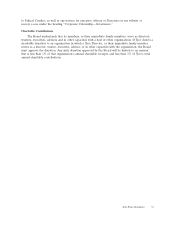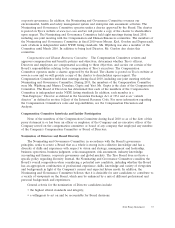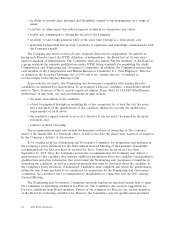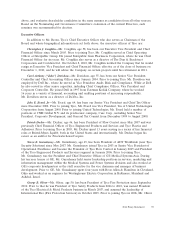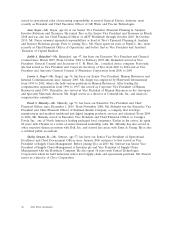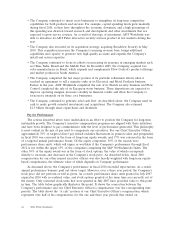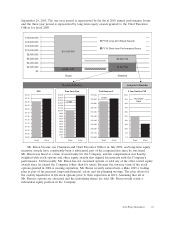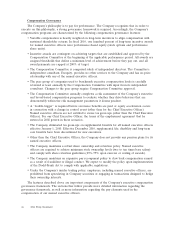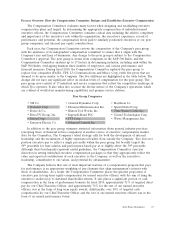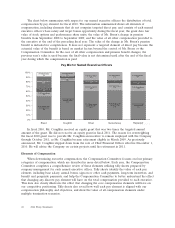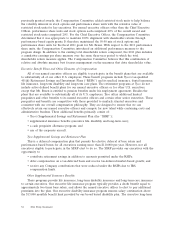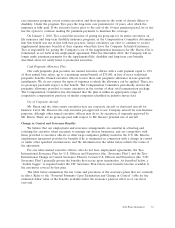ADT 2010 Annual Report Download - page 51
Download and view the complete annual report
Please find page 51 of the 2010 ADT annual report below. You can navigate through the pages in the report by either clicking on the pages listed below, or by using the keyword search tool below to find specific information within the annual report.EXECUTIVE OFFICER COMPENSATION REPORT
Compensation Discussion and Analysis
Introduction
The Compensation Discussion and Analysis section of this Proxy Statement discusses and analyzes
the executive compensation program for the named executive officers of Tyco in fiscal 2010: Edward D.
Breen, the Chairman and Chief Executive Officer; Christopher J. Coughlin, the Executive Vice
President and Chief Financial Officer through December 1, 2010; George R. Oliver, President, Safety
Products and Electrical & Metal Products; Naren K. Gursahaney, President, ADT Worldwide; and
Judith A. Reinsdorf, Executive Vice President and General Counsel. Subsequent to the end of our
fiscal year, on December 1, 2010, Mr. Coughlin stepped down from his position as Executive Vice
President and Chief Financial Officer. Effective the same date, Mr. Frank J. Sklarsky became the
Executive Vice President and Chief Financial Officer.
The Company’s executive compensation programs are based on the philosophy that they must:
(i) reinforce the Company’s business objectives and the creation of long-term shareholder value;
(ii) provide for performance-based reward opportunities that support growth and innovation without
encouraging or rewarding excessive risk; (iii) align the interests of executives and shareholders by
weighting a significant portion of compensation on sustained shareholder returns through long-term
performance programs; (iv) attract, retain and motivate key executives by providing competitive
compensation with an appropriate mix of fixed and variable compensation, short-term and long-term
incentives, and cash and equity based pay; and (v) recognize and support outstanding individual
performance and behaviors that demonstrate our core values—Integrity, Excellence, Teamwork and
Accountability.
Fiscal 2010 Executive Summary
Overall, the Company performed well in fiscal 2010, exceeding expectations in some areas and
meeting them in others. Although the global economic recession continued to impact certain of the
Company’s businesses, the service-based portion of our businesses continued to grow. Revenue in fiscal
2010 increased $134 million, or 0.8%, from fiscal 2009, driven primarily by a 3.7% favorable impact
from changes in foreign currency exchange rates (about half of the Company’s revenues are generated
outside of the U.S.). Excluding the impact of currency movements, revenue fell from last year; the
decrease in revenue was primarily driven by volume declines in Flow Control’s valves business and
weakness in commercial end markets, which drive Fire Protection Services’ systems installation and
product revenues. Although net revenue decreased, the contribution of service revenue to overall
revenue grew to 41%. Service revenues are principally derived from the ADT Worldwide and Fire
Protection Services businesses, and represent a predictable and consistent source of revenue. Operating
income during fiscal 2010 was $1.6 billion, compared to an operating loss of $1.5 billion during fiscal
2009. Operating income in fiscal 2009 was negatively affected by goodwill and intangible asset
impairment charges of approximately $2.7 billion and legacy legal settlement charges of approximately
$125 million. The improvement in the Company’s operating income in 2010 primarily reflected
efficiencies from cost containment actions taken during the economic downturn and restructuring
actions in prior years. From a cash perspective, the Company ended fiscal 2010 with a cash balance of
$1.8 billion, and generated approximately $2.6 billion of cash from operating activities.
Operationally, the Company made significant progress during 2010:
• Cost management remained a top priority. Throughout the year, the Company remained active
in identifying and executing cost containment initiatives and restructuring programs. These
actions helped offset the impact of the revenue decline described above and contributed to the
improvement in the Company’s operating margins.
2011 Proxy Statement 43


